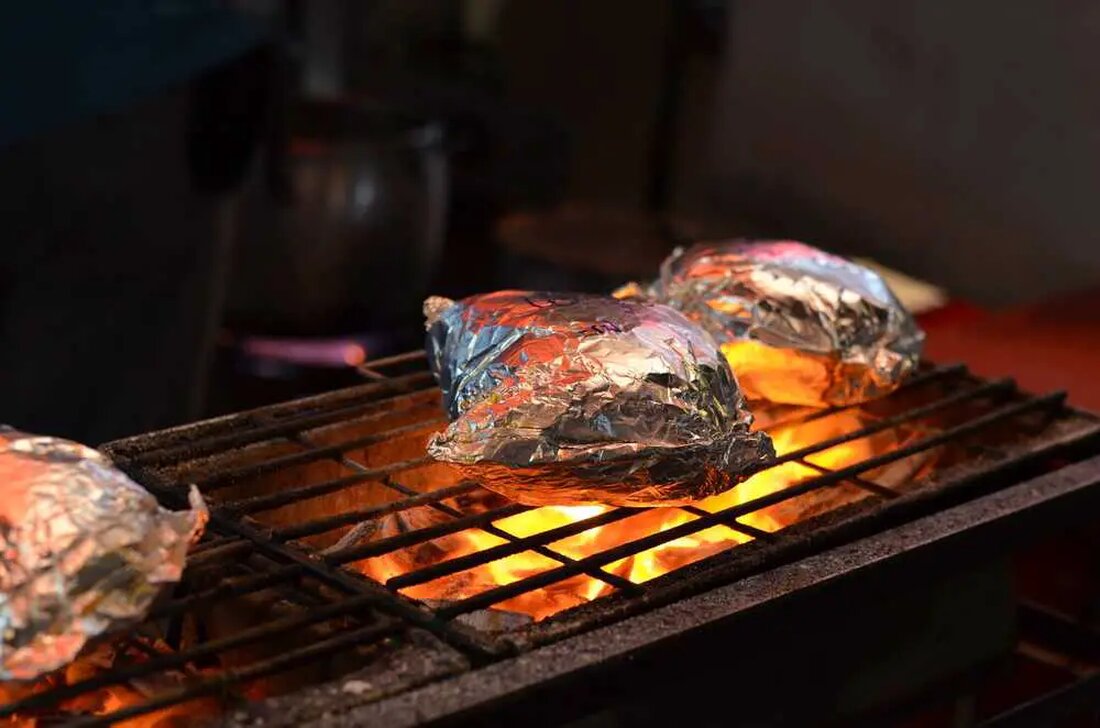The Hidden Dangers of Cooking with Aluminum Foil: Health Effects and Safer Alternatives
Aluminum foil is a staple in many kitchens and is used for everything from wrapping leftovers to lining baking sheets. However, research has shown that using aluminum foil in cooking can lead to toxic levels of aluminum in foods, which can have serious health effects. This article examines the dangers of cooking with aluminum foil and suggests safer alternatives. Aluminum Leaching During Cooking A major concern with aluminum foil is that it can leach aluminum into the foods it is cooked with. Studies have found elevated aluminum concentrations in foods prepared with aluminum foil, cookware and utensils, and in aluminum containers (Ertl & Goessler, 2018; ...

The Hidden Dangers of Cooking with Aluminum Foil: Health Effects and Safer Alternatives
Aluminum foil is a staple in many kitchens and is used for everything from wrapping leftovers to lining baking sheets. However, research has shown that using aluminum foil in cooking can lead to toxic levels of aluminum in foods, which can have serious health effects. This article examines the dangers of cooking with aluminum foil and suggests safer alternatives.
Aluminum leaching during cooking
A major concern with aluminum foil is that it can leach aluminum into the foods it is cooked with. Studies have found elevated aluminum concentrations in foods prepared with aluminum foil, cookware and utensils, and in aluminum containers (Ertl & Goessler, 2018; Bassioni et al., 2012; Ranau et al., 2001; Stahl et al., 2018; Dordevic et al., 2019; Cammaerts & Cammaerts, 2018; Al Juhaiman, 2012; Bamji & Kaladhar, 2000; Al Juhaiman, 2010; Semwal et al., 2006; Al Zubaidy et al., 2011; Veríssimo et al al., 2006; Bichu et al., 2019; Tietz et al., 2019).
Grilled and baked fish
A study that examined baked and grilled fish fillets wrapped in aluminum foil found that aluminum concentrations increased by a factor of 2 to 68 (Ranau et al., 2001). Grilled fish fillets accumulated more aluminum than baked fish, probably due to the higher heat exposure. Acidic ingredients like lemon juice also increased the amount of aluminum leached into the fish.
minced meat
A 2012 study measured aluminum concentrations in ground meat before and after cooking in aluminum foil (Bassioni et al., 2012). Acidic solutions, such as those containing vinegar, tomato juice or citric acid, resulted in the highest levels of aluminum leaching. In some samples, aluminum levels exceeded the upper intake recommended by the World Health Organization (WHO).
Vegetables
One study found that aluminum leaches into various vegetable extracts when cooked in an aluminum pot (Al Juhaiman, 2012). The degree of leaching varied depending on the type of vegetable, temperature, cooking time and salinity. Since tomatoes are acidic, they have accumulated the most aluminum.
Health effects of exposure to aluminum
The accumulation of aluminum in the human body can lead to several health problems, ranging from mild to serious. The body does not require aluminum, and therefore any accumulated amount can be considered toxic. Aluminum can enter the body from various sources, including consumption of foods cooked or stored in aluminum-containing materials (Bamji & Kaladhar, 2000).
Aluminum preferentially accumulates in the brain and has been linked to neurological problems such as Alzheimer's disease (Environmental Research, 2002). Some studies have shown a link between high aluminum exposure and the development of Alzheimer's disease (J Alzheimers Dis, 2011). Pregnant women and developing babies are particularly vulnerable to aluminum exposure, which can lead to developmental problems (Bichu et al., 2019).
In addition, aluminum can disrupt normal mineral metabolism in the body and contribute to a certain type of bone softening called aluminum-induced osteomalacia (Al Juhaiman, 2012). Overall, minimizing exposure to aluminum is critical to maintaining good health.
Safer alternatives to aluminum foil
- Pergamentpapier: Pergamentpapier ist eine hervorragende Alternative zu Alufolie zum Auslegen von Backblechen. Es ist ungiftig und gibt keine Schadstoffe an Lebensmittel ab. Entscheiden Sie sich für ungebleichtes Pergamentpapier für eine noch sicherere Option.
- Kasserolle mit Deckel oder Schmortopf: Die Verwendung von Pfannen mit Deckel oder das Garen in einem Schmortopf kann dazu beitragen, den Bedarf an Aluminiumfolie beim Abdecken von Speisen im Ofen oder auf dem Herd zu reduzieren.
- Pergament-Aluminiumfolie-Trick: Wenn Lebensmittel mit Alufolie abgedeckt werden müssen, legen Sie eine Schicht Pergamentpapier direkt über die Lebensmittel und eine Schicht Folie darüber. Diese Methode stellt sicher, dass das Aluminium nicht mit den Lebensmitteln in Kontakt kommt, wodurch das Risiko des Auswaschens minimiert wird.
- Edelstahl-Grillpfannen: Verwenden Sie zum Grillen von Gemüse Edelstahl-Grillpfannen, anstatt sie in Alufolie einzuwickeln. Diese Methode verhindert, dass Aluminium während des Garens mit den Speisen in Kontakt kommt.
- Aufbewahrungsbehälter aus Glas: Wählen Sie für die Aufbewahrung von Speiseresten Vorratsbehälter aus Glas, die keine Stoffe an die Lebensmittel abgeben. Diese Behälter können oft vom Ofen in den Kühlschrank gestellt werden, wodurch das Geschirr eingespart und der Bedarf an Aluminiumfolie reduziert wird.
The use of aluminum foil in cooking has been linked to leaching aluminum into food, which can have significant health effects. Research has shown that the accumulation of aluminum in the human body can lead to neurological problems, developmental problems and bone softening. To minimize exposure to aluminum, it is important to find safer alternatives to aluminum foil, such as: E.g. parchment paper, casseroles with lids, Dutch ovens, stainless steel grill pans and glass storage containers. By reducing the use of aluminum foil in cooking and food storage, we can help protect ourselves and our loved ones from the potential health risks associated with exposure to aluminum.
Sources:

 Suche
Suche
 Mein Konto
Mein Konto
